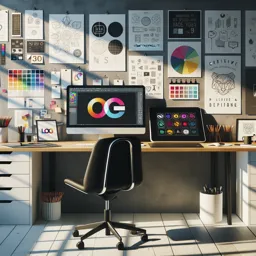Introduction to Typography
Typography forms the backbone of graphic design, influencing the readability, mood, and overall visual appeal of a design. Mastering typography is essential for anyone interested in creating professional and engaging design projects, whether for print, web, or multimedia applications.
What is Typography?
Typography is the art and technique of arranging type. It involves choosing typefaces, point sizes, line lengths, line spacing, and letter spacing, as well as adjusting the relationship between pairs of letters (kerning). Good typography ensures that text is not only legible, but also communicates its message effectively and supports the visual narrative.
The Principles of Typography
- Legibility: Ensuring the type is easy to read at various sizes and distances.
- Hierarchy: Establishing a clear visual order to guide the reader’s attention.
- Alignment: Using consistent alignment enhances organization and prepares the viewer’s eye to move through content smoothly.
- Contrast: Utilizing differences in weight, size, color, or typeface to emphasize important information.
- Consistency: Maintaining uniform text style across a project builds brand identity and coherence.
Typography Classifications
Understanding the main font classifications helps designers choose the right style for their projects:
- Serif: Fonts with decorative strokes, ideal for print and traditional designs (e.g., Times New Roman).
- Sans Serif: Clean, modern fonts without extra strokes, commonly used for digital content (e.g., Helvetica, Arial).
- Script: Fonts that mimic handwritten or calligraphic styles, often used for invitations or logos.
- Display: Highly stylized fonts designed for attention-grabbing headlines or titles.
- Monospaced: Fonts with evenly spaced letters, frequently used in coding and technical materials.
Choosing and Pairing Fonts
Selecting appropriate fonts is more than picking favorites. Consider the project’s goals, audience, and medium. Effective font pairing typically involves combining a primary font (for headlines) with a complementary secondary font (for body text), ensuring visual harmony while maintaining readability. Limit the number of fonts per project—too many variations can cause confusion and diminish professionalism.
Creative Applications of Typography
Typography offers many opportunities for creative expression. Designers use typography to evoke emotion, convey brand identity, and create memorable visual experiences. Techniques like manipulating type paths, using negative space, or integrating typography with images can elevate a design from ordinary to extraordinary.
Tips for Improving Your Typography Skills
- Practice: Experiment with different type families, layouts, and effects.
- Study: Observe how professional designs use type and mimic their strategies.
- Feedback: Seek critique from other designers to refine your skills.
- Resources: Explore online courses, design blogs, and typography communities to stay updated on trends and best practices.
Conclusion
Typography is a fundamental element in design, impacting communication, aesthetics, and user experience. By understanding its principles and experimenting with different typographic styles, designers can significantly enhance their projects’ effectiveness and appeal.

































